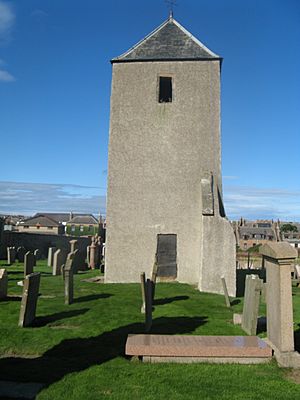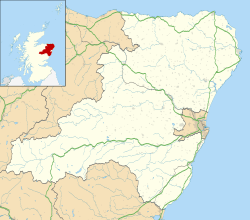Old St Peter's Church, Peterhead facts for kids
Quick facts for kids Old St Peter's Church |
|
|---|---|

The church in 2013, looking northeast
|
|
| 57°30′16″N 1°47′26″W / 57.504506°N 1.790544°W |
Old St Peter's Church, also called St Peter's on the Links, is a very old building in Peterhead, Aberdeenshire, Scotland. It's a special historical site known as a scheduled monument. While its main tower from the Middle Ages is still standing, most of the church is now in ruins. Some parts of these ruins are from as far back as the 1100s! The pyramid-shaped roof on the tower probably dates from the 1700s.
Contents
The Church's Long History
Early Days and Changes
Old St Peter's Church was once known as Peterhead Parish Church of Peterugie. It was first looked after by the Bishop of Dunkeld. In 1218, the church became part of Deer Abbey.
Later, in 1543, a powerful person named William Keith, 3rd Earl Marischal, took charge of the church's income. In 1587, the church was given to the Crown. However, the land around it was kept, and a special town area called a "burgh of barony" was created in 1593.
New Owners and Abandonment
The Earl Marischal's lands were taken by the government in 1716. The church was then sold to a company called York Buildings Company in 1720. This company later went out of business in 1786.
After that, in 1728, the church was sold to the Trustees of Merchant Maiden Hospital and Mary Erskine. These groups appointed a leader for the town, called a provost, and three assistants called bailies.
The church was no longer used after 1771. A new church was built nearby at that time.
Becoming a Scheduled Monument
Old St Peter's Church was first recognized as a special building in 1971. It was given "Category A listed" status. Then, in 2016, it was made an even more important historical site. It became a scheduled monument, which protects it for the future.
The Graveyard
The graveyard around Old St Peter's Church is also very old and important. It has a "Category B listed" status. You can find many old gravestones there, mostly from the 1600s, 1700s, and early 1800s. A newer part of the graveyard was added on the south side.
Images for kids
See also
- Scheduled monuments in Aberdeenshire




